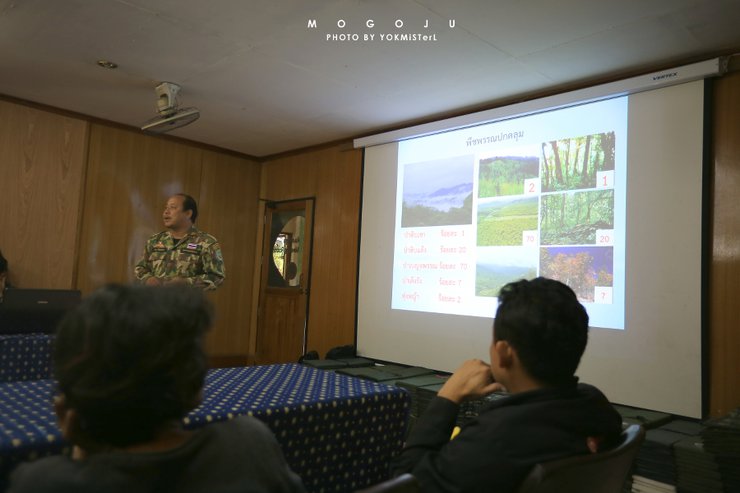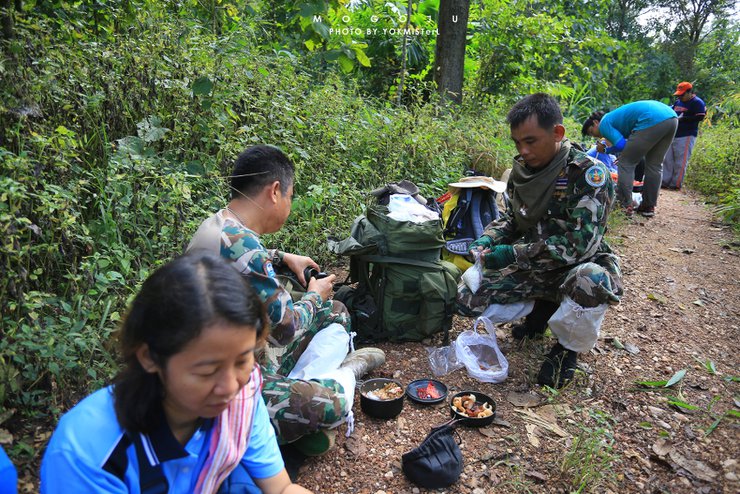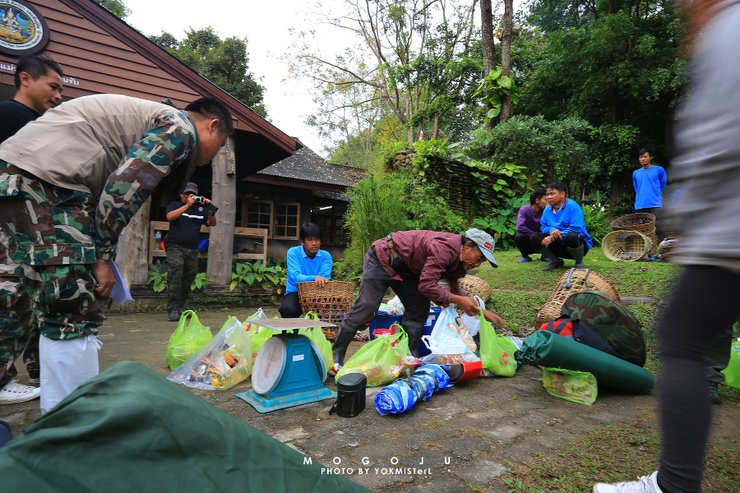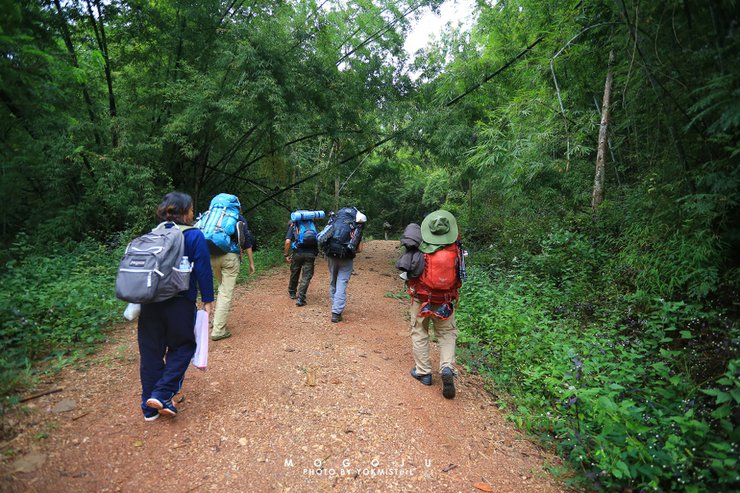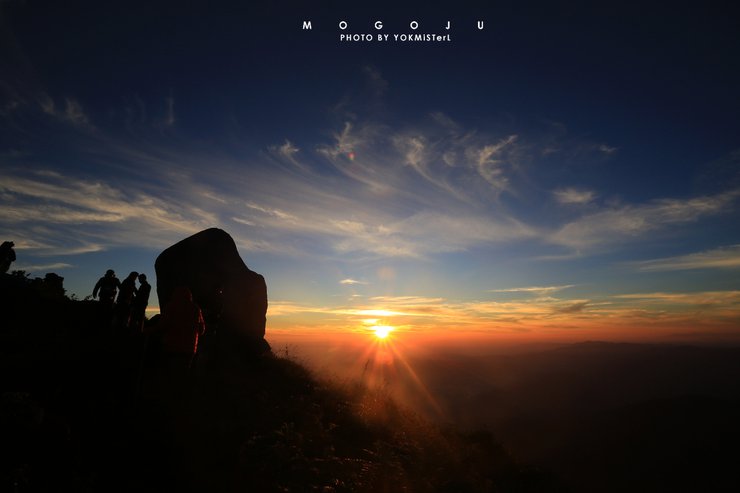"My mother's words, "Let's go to Yae Mo Ko Chu," accompanied her photos of a five-day, four-night trek covering 64 kilometers and ascending 1,964 meters above sea level. I was initially perplexed, wondering if Yae Mo Ko Chu was in Japan. To my surprise, my mother informed me it was in Kamphaeng Phet Province. I immediately resolved to conquer Yae Mo Ko Chu that year. When Mae Wong National Park opened reservations for the Yae Mo Ko Chu long-distance hike, I eagerly secured a spot.据说预订 Yae Mo Ko Chu 徒步旅行非常困难,但这次旅行要感谢“Uncle Tee”,他成功预订了这次旅行,让我们得以进行 Yae Mo Ko Chu 徒步旅行,并分享我们的徒步体验。我们是第三组,共有 12 名成员,于 12 月 17 日至 21 日前往 Mae Wong 国家公园。"

December 16, 1959
Today, we had to travel to Mae Wong National Park first because we had to report at 8:00 am tomorrow morning. So, we planned to stay at the park's accommodation beforehand. We drove ourselves, with 8 members in total. Imagine a 7-seater Fortuner car filled with cooking equipment, canned food, snacks, dried food, and our luggage. Add to that 8 people crammed into the car, and 10 bags of rice, each weighing 2 kg, that we bought at Big C Nakhon Sawan, squeezed between everyone's seats. "Am I sitting in a car or on someone's lap?" Uncle (a man) complained. Haha. The fun started even before we began our journey. We arrived at Mae Wong National Park in Kamphaeng Phet Province around 10:00 pm. We then took care of our business and prepared for the next day's adventure.
17.12.59
This appears to be a date in the format "DD.MM.YY", which translates to December 17, 1959.
This morning, the officers scheduled us for a briefing on the long-distance trekking to Mokochu. During this trip, there will be two officers accompanying us and porters that we need to hire (the number of porters depends on our needs). There will be three porters accompanying our trip. Each porter can carry a maximum of 20 kg of our belongings. Before breakfast, we need to weigh all the items we will be taking with us. For food items (rice, canned fish, instant noodles, etc.), it is recommended to bring plenty of chocolate as it will be very helpful. Sweet drinks are also highly recommended. Remember to bring essential items such as sleeping bags and tents. Don't forget allergy medication, insect repellent, and muscle relaxants. These are very important, especially on the third day when they will be most needed.



This morning's breakfast was stir-fried pork with holy basil. Many people say that the stir-fried pork with holy basil here is delicious. We have to agree that it is indeed delicious.

After lunch, the officers explained the long-distance trekking route. The trek to Mokochu has three types of trails: the first is a gentle climb from the office to Mae Krasa Camp; the second is a moderate climb from Mae Krasa Camp to Mae Reua Camp; and the third is a steep climb with minimal flat sections from Mae Reua Camp to the summit of Mokochu (a daunting prospect!). After the briefing, the officers distributed lunch packs for us to carry and eat during the trek.

It's time to hit the road!
Today, we will be trekking from the park headquarters to Mae Krasa Camp, a distance of 16 km. A park ranger will guide our group of 12 members. The initial part of the trail is relatively easy, with a wide and gently sloping path. While I found the walk quite comfortable, Jade struggled a bit and almost fainted on the steeper sections. Thankfully, our fellow trekkers were there to lend a helping hand.
The sun can be quite intense during the hike to Mae Krasa Camp, so a hat is highly recommended. Be prepared to cross several streams, which are not too deep. Bringing along a pair of sandals to wear while crossing the streams would be a wise choice.



For lunch, we stopped to eat the packed lunch we had prepared earlier in the morning. This was a change from our usual lunch routine. The Mae Wong forest is relatively intact, and throughout the journey, we encountered elephant dung and footprints of various animals, ranging from small to large, including big cats (tigers).



Can anyone identify this insect? It's beautiful and cute, resembling a ladybug.


12 km. The sign gave us hope. Let's take a break and then continue our journey.
Note: The provided text is empty. There is nothing to translate.


We finally arrived at Mae Krasa Camp. It took us from 10:00 AM to 4:00 PM to cover the 16 km distance to Mae Krasa Camp. The camp has restrooms available, but they are only for using the toilet, not for showering. To bathe, you must use the stream. The stream water is clean, cool, and delicious. If you come to Mokochu, you must try it! 555


Let me introduce you to "Uncle Fah," a member of the Musoe ethnic group. Uncle Fah is a porter who carried supplies for our trip. He is a very kind man. Upon arriving at the camp, he cooked rice and tea for us, and even gathered wild vegetables for our meals. Uncle Fah also loves to tell stories about his life, which we understood to varying degrees. If you ever hike Mount Mogokju and meet Uncle Fah as your porter, consider yourself very lucky!

Another thing that Mogokju enjoys is bathing in the stream. It's not often that we have the opportunity to bathe in a stream, to do things that life doesn't often allow. It's a fun thing to try.

Tonight's dinner was prepared by "Auntie," a skilled chef and avid hiker with a wealth of knowledge. The meal was enjoyed under the romantic glow of candlelight, as there was no electricity available. 555


This is called "broom grass tea," a medicinal herb found in the forest. Uncle Fah boiled it for us to drink. He said that this herb helps to cleanse the bladder. Drinking a lot of it will make you urinate frequently. P.S. The ladle you see was made by Uncle Fah from bamboo.

Since entering the forest, I haven't touched my mobile phone at all because there is no signal. It's a good thing, though. It allows us to be more present with our surroundings, talk to the people around us more, and see nature that is hard to find in the city. The sky is full of stars, with no empty space at all. It's a real gift for city dwellers like us. Time to rest and get ready for tomorrow.


December 18, 1959
Day 2: A Short Hike to Mae Reua Camp and Waterfall
Today's journey takes us from Mae Krasa Camp to Mae Reua Camp, a distance of 4 km. We will also hike to Mae Reua Waterfall, adding another 6 km to our roundtrip journey. You might be wondering why we are only hiking 4 km on Day 2. Well, the real challenge lies ahead on Day 3, so today is a輕鬆的 warm-up to build our strength.
This morning, we need to remove unnecessary items from our backpacks to lighten our load for tomorrow's demanding hike. Remember, every gram counts! However, it's crucial to keep essential medications and energy-boosting snacks like sweets readily accessible. These will be invaluable on Day 3.


Ready to travel, the path is convenient and not too difficult. The path is still comfortable to walk on.




We have arrived at Mae Reua Camp! We started our trek from Mae Krasa Camp at 8:00 AM and reached Mae Reua Camp just in time for lunch. After lunch, we will hike another 6 km (roundtrip) to Mae Reua Waterfall. Mae Reua Camp has restrooms, but you will need to collect water from the stream for personal use. There is also a stream where you can refill your water bottles.



After lunch, we continued walking to Mae Ree Wa Waterfall. At that time, I thought to myself, "Oh, 3 km. Easy peasy. I've already walked 16 km. No problem." I shouldn't have thought that way. It was the most challenging 3 km. I've ever walked. It was like a test before climbing Mo Ko Chu. 555 If you're going to play in the water, be sure to bring a change of clothes. Otherwise, you'll be cold.



After returning from Mae Ree Waterfall, we jumped into a nearby stream for a refreshing dip. After showering and having dinner, the park rangers gathered around Uncle Fah and asked him to share his stories by the campfire. Uncle Fah's tales were both humorous and engaging, showcasing the invaluable lessons learned through real-life experiences, beyond the confines of textbooks. These daily encounters serve as life's lessons, and Uncle Fah embodies this wisdom with his full 100 points.


December 19, 1959
Today is the day we will conquer the peak of Doi Mokkoju. We had to wake up early to reach the summit before sunset. We started our trek at 5:00 AM, covering a distance of 8 km (8 km of "Mae"). While 8 km might not seem daunting, it was anything but. It was incredibly challenging. The trail seemed endless, and unlike the previous two days of flat terrain, this was a constant uphill climb. We had to cross several hills, stopping at Klong 1 to refill our water bottles. There would be one more refill opportunity at Klong 2 before reaching the campsite. We recommend filling up as much as you can, as there is no water source at the top. Many have heard of the infamous leeches and snails of Mokkoju. While the leeches are indeed plentiful, the real menace is the "wind tick." These ticks are relentless and will bite you without hesitation. If you're planning to hike Mokkoju, avoid sitting on damp logs or rocks, as these are prime habitats for wind ticks. They are notoriously difficult to kill, so wearing long sleeves, pants, and socks is crucial. Additionally, there are no showers at the campsite, so be prepared to get salty with your fellow hikers. So, watch out for those wind ticks!




16:00 - Arrival at Campsite and Hike to Mo Ko Chu Peak
After a 12-hour journey, we finally arrived at our campsite at the foot of the mountain. We were famished and immediately devoured instant noodles, which tasted like the most delicious meal we had ever had. However, our journey wasn't over yet. The famous Mo Ko Chu peak, with its iconic sailboat-shaped rock, still awaited us.
Fueled by our instant noodle feast, we embarked on a 1-kilometer hike to the peak. As we entered the trail leading to Mo Ko Chu, our fatigue and weariness vanished. The breathtaking scenery completely captivated us, making us forget all about our exhaustion.

The view along the path leading to the top of Mount Mogokju is breathtaking. Be sure to arrive before sunset to fully appreciate its beauty.

It is unbelievable that this forest will be turned into a dam. From the highest point of this peak, it is clear that the Mae Wong Dam should not be built. If you climb to the top of Mokochu, look around and decide for yourself whether the Mae Wong Dam should be built.



We have arrived! We have conquered the summit of Mount Mogokju! At that moment, I felt a sense of pride in overcoming my fatigue, my weariness, and my discouragement. I had walked so far, and it seemed like I would never reach the top. But I never gave up. I kept pushing forward, one step at a time. Thank you to my heart for never giving up. Thank you to my legs for carrying me to the top, even though they were so tired.






The sun sets, a warm embrace. Standing still, I watch, savoring the moment. The beauty of Mokochu lives up to its name.




December 20, 1959
The 4:00 AM alarm is a signal that it's time to watch the sunrise. It's time to walk up to see the sun work. The path is quite dark and slippery, so be careful not to slip and fall off the cliff. The entire path to the top of Mokochu is a cliff.

The evening was beautiful, but the morning was beautiful in a different way. The sun was out and working, which was a sign that we had to keep moving. 555







"Missing Father" Although Mogokju is not the highest mountain... it is the closest to father.

After descending from the summit of Mount Mokochu, officials distributed "Mokochu Summit Conqueror" ribbons. This year marks the first year of distribution, commemorating the 30th anniversary.

Farewell, Mount Mogokju!
After capturing the breathtaking views of Mount Mogokju, we descended to enjoy breakfast before returning to Mae Krasa Camp. We opted to skip the overnight stay at Mae Rewa Camp and head straight to Mae Krasa, stopping only to collect our belongings and have lunch.
The descent from Mount Mogokju proved to be twice as challenging as the ascent, as it involved a continuous downhill trek. This put a strain on our knees, legs, and calves. While the descent was quicker due to the lack of uphill climbs, we had to be cautious of slippery sections caused by the steep terrain.
We arrived at Mae Krasa Camp around 4:00 PM, eager to jump into the shower after a day without one. The feeling of washing away the sweat and grime was pure bliss!


December 21, 1959
The last day of the trip, I must say I felt a pang of sadness. I didn't want to go back. After our final breakfast in the forest, we set off at 7:00 AM to reach the park headquarters by 12:00 PM. The sky was exceptionally beautiful that day, and the sun was particularly hot.

The little snail sent us home. See you next time.



"When Uncle Sombut, the park ranger, turned to me and said, 'Turn around and look! See the peak above the clouds? That's the summit of Mount Mokochu, where we just came from.' At that moment, I thought to myself, 'How did I manage to walk all the way up there?'"

We arrived at the park headquarters at 2:00 PM, marking the end of our long hike in the Mogoju Mountains. Thank you, Mogoju. This hike was the longest we've ever done, and we accomplished things we never thought we could. It was an incredible experience. While some may say that Mogoju is not worth the climb because the views along the way are not as beautiful as other mountains, we believe that Mogoju offers more than just the Sail Rock. It also provides camaraderie along the way and good company. Thank you, Mogoju. You will want to come and use your heart to walk to Mogoju.

Thank You for Conquering Your Limits
This passage expresses heartfelt gratitude for a challenging and rewarding journey. The author thanks various individuals who contributed to their success, acknowledging their own physical and mental strength, the support of fellow travelers, and the kindness of those who provided guidance and assistance along the way.
Key Points:
- The author expresses appreciation for overcoming fatigue and pushing forward despite exhaustion.
- They acknowledge the support of their 12 fellow travelers and the constant care of the trip organizers.
- Specific individuals are thanked for their contributions, including:
- Uncle Somchai, Uncle Nu, and Bank for their consistent support throughout the five-day journey.
- Uncle Fa for his excellent care as a porter.
- Uncle Tee for providing snacks that fueled the author's energy.
- Uncle A for his assistance and the gift of socks.
- Tak and Yook for bringing laughter and smiles to the journey.
- Pa for taking care of the goats, preparing meals, and creating laughter.
- Palm for looking after Pa and the goats, and for the flysheet.
- Arm for teaching astrophotography and providing care throughout the trip.
- The author's mother, uncle, and aunt for their constant support.
- Most importantly, the owner of the borrowed shoes, Dream, for enabling the author to reach the summit of Mount Mokochu.
Overall, the passage conveys a deep sense of gratitude for the collective effort and individual contributions that made the challenging journey possible.

Thank you, Mo Ko Ju, for showing me that there's more to life than just sailing stones...
Thank you, hardship, for showing me who truly loves and cares for me.
Thank you, my heart, for never giving up.
Thank you, Mo Ko Ju.
Thank you to everyone who has read this review. If you've been there, please come back and share your story. Let's share our feelings together.



YOKMiSTerL
Friday, October 4, 2024 3:06 PM





